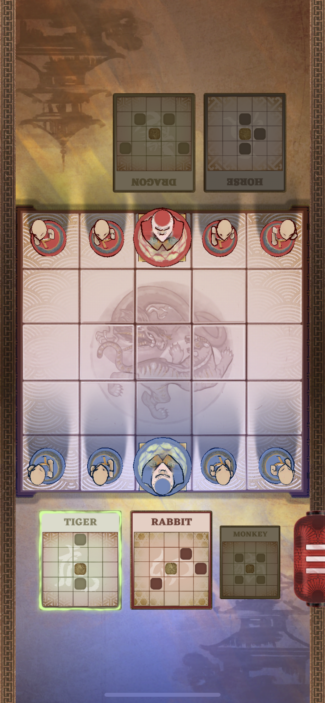Bastion
LQ: 9.15
Recommended Age: 10+
Skills Used: Planning, Working Memory, Mathematics, Reading

Onitama: The Board Game is a strategy game with elements of Japanese culture and chess-like game play. The board is a 5 by 5 grid and each player has four student pieces and one master piece. The master is placed on a temple square in the middle of the board on the player’s side. The goal is to either eliminate your opponent’s master or get your master to your opponent’s temple. To do this, there are five move cards in each game. They have names like monkey and dragon and show how the player may move their pieces. Each turn, the player picks one move card and one piece and then moves the piece according to the card.
There are multiple modes, including solo and online play. Onitama: The Board Game has in-game purchases and ads. The ESRB rated it E for Everyone and LW4K stands by this rating.
Onitama: The Board Game helps kids practice and improve the following skills:
 Flexibility
FlexibilityAdapting and adjusting to changing conditions and expectations.
This game provides two opportunities for the player to practice flexibility. First, every game the players only have five move cards out of their deck that they can use. This means every game will have a slightly different combination of move cards the player is confined to. No matter how much they like the monkey card, they will have to be flexible enough to use other cards. Secondly, the players don’t have a specific order that they have to use the move cards. This means even if the player plans on their opponent using dragon, they may not. Which means if the player wants to be successful and win the game, they have to be flexible in case the opponent doesn’t act the way they expected.
Developing and retaining information in our minds while working.
This game provides a great chance to practice problem solving skills and short-term planning. Problem solving happens every turn as the player has to evaluate which move card and which piece are best to use that round. Short-term planning happens as the player looks at their possible moves and thinks about how the opponent will react to that move (as well as what move the opponent might counter with). The player can even go a step further and think about what move they will use after the opponent’s turn. If the player isn’t using these planning skills, he or she will end up making a mistake and losing the game.
All membership plans come with full access to our entire suite of tools learning guides, and resources. Here are a few of the ones we think you’ll like the most: